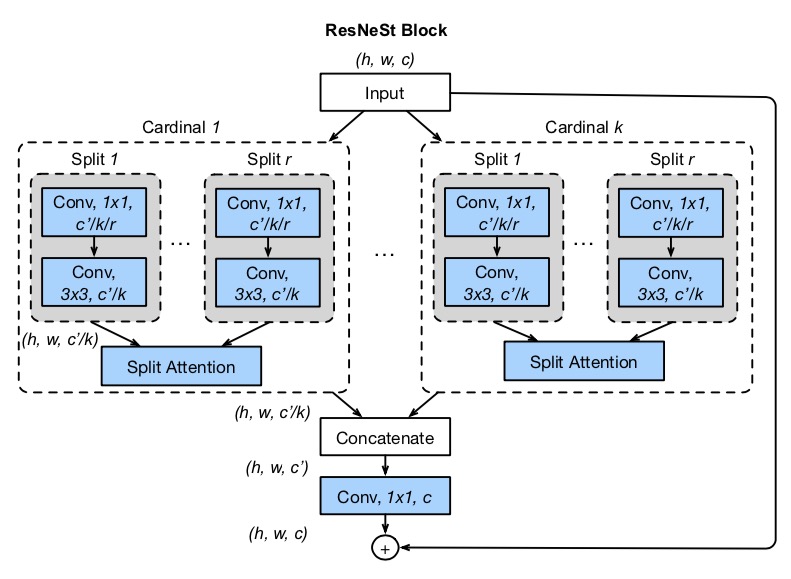import torch
# 모델 목록 불러오기
torch.hub.list('zhanghang1989/ResNeSt', force_reload=True)
# 예시로 ResNeSt-50을 사용하여 사전 훈련된 모델을 가져오기
model = torch.hub.load('zhanghang1989/ResNeSt', 'resnest50', pretrained=True)
model.eval()
모든 사전 훈련된 모델은 동일한 방식으로 정규화된 입력 이미지를 요구합니다.
즉, H와 W가 최소 224의 크기를 가지는 (3 x H x W)형태의 3채널 RGB 이미지의 미니배치가 필요합니다.
이미지를 [0, 1] 범위로 불러온 다음 mean = [0.485, 0.456, 0.406], std = [0.229, 0.224, 0.225]를 이용하여 정규화해야 합니다.
다음은 실행예시입니다.
# 파이토치 웹 사이트에서 예제 이미지 다운로드
import urllib
url, filename = ("https://github.com/pytorch/hub/raw/master/images/dog.jpg", "dog.jpg")
try: urllib.URLopener().retrieve(url, filename)
except: urllib.request.urlretrieve(url, filename)
# 실행예시 (torchvision이 요구됩니다.)
from PIL import Image
from torchvision import transforms
input_image = Image.open(filename)
preprocess = transforms.Compose([
transforms.Resize(256),
transforms.CenterCrop(224),
transforms.ToTensor(),
transforms.Normalize(mean=[0.485, 0.456, 0.406], std=[0.229, 0.224, 0.225]),
])
input_tensor = preprocess(input_image)
input_batch = input_tensor.unsqueeze(0) # create a mini-batch as expected by the model
# GPU 사용이 가능한 경우 속도를 위해 입력과 모델을 GPU로 이동
if torch.cuda.is_available():
input_batch = input_batch.to('cuda')
model.to('cuda')
with torch.no_grad():
output = model(input_batch)
# ImageNet의 1000개 클래스에 대한 신뢰도 점수를 가진 1000 형태의 Tensor 출력
print(output[0])
# 출력은 정규화되어있지 않습니다. 소프트맥스를 실행하여 확률을 얻을 수 있습니다.
probabilities = torch.nn.functional.softmax(output[0], dim=0)
print(probabilities)
# ImageNet 레이블 다운로드
!wget https://raw.githubusercontent.com/pytorch/hub/master/imagenet_classes.txt
# 카테고리 읽어오기
with open("imagenet_classes.txt", "r") as f:
categories = [s.strip() for s in f.readlines()]
# 이미지마다 상위 카테고리 5개 보여주기
top5_prob, top5_catid = torch.topk(probabilities, 5)
for i in range(top5_prob.size(0)):
print(categories[top5_catid[i]], top5_prob[i].item())
모델 설명
ResNeSt 모델은 ResNeSt: Split-Attention Networks 논문에서 제안되었습니다.
최근 이미지 분류 모델이 계속 발전하고 있지만 객체 감지 및 의미 분할과 같은 대부분의 다운스트림 애플리케이션(downstream applications)은 간단하게 모듈화된 구조로 인해 여전히 ResNet 변형을 백본 네트워크(backbone network)로 사용합니다. 기능 맵 그룹 전반에 걸쳐 주의를 기울일 수 있는 Split-Attention 블록을 제시합니다. 이러한 Split-Attention 블록을 ResNet 스타일로 쌓아서 ResNeSt라고 하는 새로운 ResNet 변형을 얻습니다. ResNeSt 모델은 유사한 모델 복잡성을 가진 다른 네트워크보다 성능이 우수하며 객체 감지, 인스턴스 분할(instance segmentation) 및 의미 분할을 포함한 다운스트림 작업을 지원합니다.
| crop size | PyTorch | |
|---|---|---|
| ResNeSt-50 | 224 | 81.03 |
| ResNeSt-101 | 256 | 82.83 |
| ResNeSt-200 | 320 | 83.84 |
| ResNeSt-269 | 416 | 84.54 |

